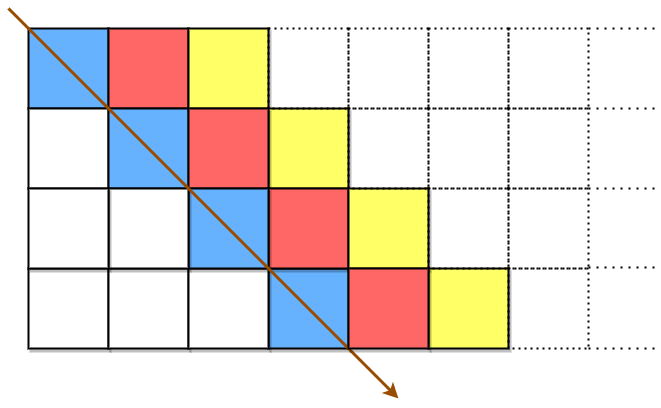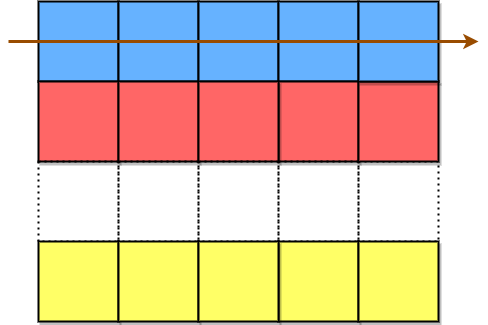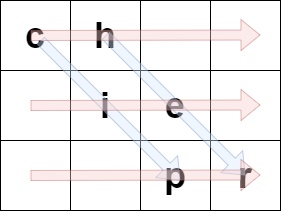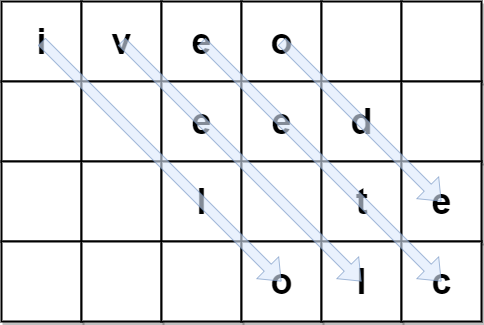
g2001_2100.s2075_decode_the_slanted_ciphertext.Solution Maven / Gradle / Ivy
Go to download
Show more of this group Show more artifacts with this name
Show all versions of leetcode-in-java21 Show documentation
Show all versions of leetcode-in-java21 Show documentation
Java-based LeetCode algorithm problem solutions, regularly updated
package g2001_2100.s2075_decode_the_slanted_ciphertext;
// #Medium #String #Simulation #2022_05_29_Time_48_ms_(68.23%)_Space_77.9_MB_(64.71%)
/**
* 2075 - Decode the Slanted Ciphertext\.
*
* Medium
*
* A string `originalText` is encoded using a **slanted transposition cipher** to a string `encodedText` with the help of a matrix having a **fixed number of rows** `rows`.
*
* `originalText` is placed first in a top-left to bottom-right manner.
*
* 
*
* The blue cells are filled first, followed by the red cells, then the yellow cells, and so on, until we reach the end of `originalText`. The arrow indicates the order in which the cells are filled. All empty cells are filled with `' '`. The number of columns is chosen such that the rightmost column will **not be empty** after filling in `originalText`.
*
* `encodedText` is then formed by appending all characters of the matrix in a row-wise fashion.
*
* 
*
* The characters in the blue cells are appended first to `encodedText`, then the red cells, and so on, and finally the yellow cells. The arrow indicates the order in which the cells are accessed.
*
* For example, if `originalText = "cipher"` and `rows = 3`, then we encode it in the following manner:
*
* 
*
* The blue arrows depict how `originalText` is placed in the matrix, and the red arrows denote the order in which `encodedText` is formed. In the above example, `encodedText = "ch ie pr"`.
*
* Given the encoded string `encodedText` and number of rows `rows`, return _the original string_ `originalText`.
*
* **Note:** `originalText` **does not** have any trailing spaces `' '`. The test cases are generated such that there is only one possible `originalText`.
*
* **Example 1:**
*
* **Input:** encodedText = "ch ie pr", rows = 3
*
* **Output:** "cipher"
*
* **Explanation:** This is the same example described in the problem description.
*
* **Example 2:**
*
* 
*
* **Input:** encodedText = "iveo eed l te olc", rows = 4
*
* **Output:** "i love leetcode"
*
* **Explanation:** The figure above denotes the matrix that was used to encode originalText.
*
* The blue arrows show how we can find originalText from encodedText.
*
* **Example 3:**
*
* 
*
* **Input:** encodedText = "coding", rows = 1
*
* **Output:** "coding"
*
* **Explanation:** Since there is only 1 row, both originalText and encodedText are the same.
*
* **Constraints:**
*
* * 0 <= encodedText.length <= 106
* * `encodedText` consists of lowercase English letters and `' '` only.
* * `encodedText` is a valid encoding of some `originalText` that **does not** have trailing spaces.
* * `1 <= rows <= 1000`
* * The testcases are generated such that there is **only one** possible `originalText`.
**/
public class Solution {
public String decodeCiphertext(String encodedText, int rows) {
if (rows == 1) {
return encodedText;
}
int total = encodedText.length();
int cols = total / rows;
char[][] grid = new char[rows][cols];
int index = 0;
for (int i = 0; i < rows; i++) {
for (int j = 0; j < cols; j++) {
grid[i][j] = encodedText.charAt(index++);
}
}
StringBuilder sb = new StringBuilder();
int colIndex = 0;
while (colIndex < cols) {
for (int j = colIndex, i = 0; j < cols && i < rows; j++, i++) {
sb.append(grid[i][j]);
}
colIndex++;
}
int i = sb.length() - 1;
while (i >= 0 && sb.charAt(i) == ' ') {
i--;
}
return sb.substring(0, i + 1);
}
}
© 2015 - 2025 Weber Informatics LLC | Privacy Policy